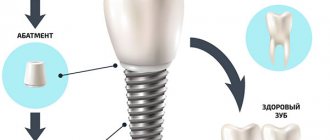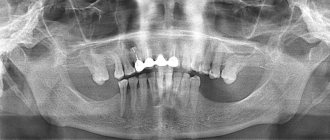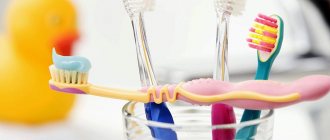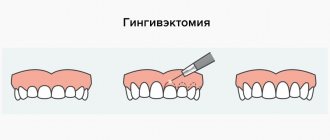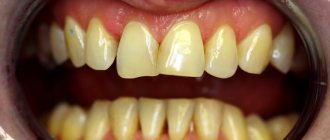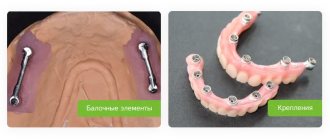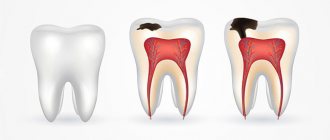Review of CEREC technology (“Cerec”) – features, why it is needed, advantages and disadvantages
Article navigation
- CEREC technology – what is it?
- Application area
- What is included in the CEREC complex
- Stages of making prostheses
- Benefits of technology
- What are the disadvantages
- Cost of CEREC restorations in Moscow and other cities
Question for a specialist
Modern computer technologies are actively used in all spheres of our lives. And medicine is no exception. In dentistry, they are needed for dental treatment, implantation, and also the creation of various dentures. Moreover, such technologies are capable of producing not only very high-quality prostheses, but also doing it very quickly. For example, Cerec crowns and CEREC inlays and veneers can be produced in just a few minutes. In the next article we will tell you what the CEREC system is, its scope of application, its advantages and the cost of restorations.
CAD/CAM system technology in dentistry and manufactured prostheses
Computer technologies are becoming more and more closely integrated into everyday life, science and production. They are actively used in all branches of medicine. Existing computer programs calculate the functioning parameters of individual body systems and accompany diagnostic processes and therapeutic measures.
The software is also used in dental practice. Moreover, the share of procedures performed using computer technology is steadily increasing, despite their higher cost. Each clinic and individual specialist, understanding all the advantages that the use of computer software guarantees, tries to provide services of the highest possible quality. Without the use of digital capabilities at the present stage, this will not be achieved. They are used in orthopedic dentistry, implantation, when correcting bites, and eliminating dysfunction of the temporomandibular joint.
One of the most popular techniques in dental practice is CAD/CAM prosthetics. (The name consists of the initial letters of the term Computer Aided Design/Computer Aided Manufacture). Following it, it becomes clear that we are talking about a technological process that combines computer modeling with the subsequent production of orthopedic structures.
The resulting prostheses in this case differ most favorably from analogues made in an alternative way, using casting, stamping, and soldering. High manufacturing precision, as well as the physical properties of the material, allow:
- significantly extend the service life of teeth restored with ceramic inlays;
- a non-removable design made using digital technology is guaranteed to have impeccable aesthetic qualities, no adjustment period, and a long service life.
The process of obtaining and installing ceramic veneers and inlays in general became popular only with the advent of digital technologies that guarantee high precision of the process. Before this, the possibility of obtaining an aesthetic and long-term result was doubtful.
CEREC technology – what is it?
CEREC technology is the creation of various dentures from high-quality ceramics and zirconium dioxide using special programs and modern computerized milling equipment. In its full form, the name CEREC stands for “Chairside Economical Restorations of Esthetic Ceramic” and means “economical and aesthetic ceramic prosthetics.”
The Cerek complex was developed in the 80s of the twentieth century in Zurich, and is currently produced by the dental concern Dentsply Sirona from the USA. This is a very large enterprise that produces everything for the field of dentistry - filling materials, treatment instruments, orthodontic aligners (silicone “braces”), implants of the brands Astra Tech, Ankylos, XiVE.
South Korean implant Osstem - from 35,000 rubles.
Hurry up to sign up for a free consultation and lock in promotional prices.
Call now or request a call
Opening hours: 24 hours a day - seven days a week
The essence of the method.
The principle of the method is that, using Cerec equipment, the patient is fitted with a ceramic prosthesis (crown, veneer, inlay) made with pinpoint precision within two to three hours. The whole procedure takes place in several stages.
Preparation of the tooth and preparing it for restoration. To do this, the area is treated with a special white powder that does not allow the tooth to glare. A 3D oral camera then takes fixed images of the repaired surface. The resulting image is processed by a computer, resulting in a three-dimensional model of the crown or inlay. This takes into account the bite, the anatomical structure of neighboring teeth, the characteristics of jaw movement, the color of natural enamel and many other very specific nuances. The doctor controls this process from the monitor screen, magnifying the image 12 times.
Once the computer simulation of the Cerec crown is completed, all information is transferred to the grinding unit, where the prosthesis is ground. Two diamond cutters operating in six planes grind the ceramic workpiece with high precision. Within twenty minutes the patient can observe the “birth” of a new tooth. You can learn more about this procedure at a free consultation at a dental clinic.
Adhesive material is used to fix the tab. The high degree of adherence of the veneer to the edge of the tooth leads to the fact that there are practically no connecting seams.
The entire procedure can take up to 3 hours, while standard prosthetics - taking impressions, making a crown in the laboratory by hand and subsequent installation - usually takes 3-4 visits to the dentist.
Cerec technology uses industrial porcelain as a starting material with high levels of uniformity, light reflection and strength. This allows you to create exact analogues of tooth enamel when installing veneers, practically indistinguishable in properties and characteristics. The ceramic material of the crown lends itself well to polishing and giving the desired shade that matches the natural color.
This is interesting! There have been 20,000,000 successful restorations since the introduction of Cerek technology. This indicator is a compelling reason to fully trust patient reviews and count on high efficiency of restoration.
Scope of application of the CEREC system
- creating recovery tabs,
- production of ceramic and zirconium crowns and bridges CEREC: both on natural teeth and on implants. Moreover, crowns on implants can be created for both cement and screw fixation,
- production of veneers: thin overlays on the front surface of teeth,
- creation of individual abutments for dental implants,
- creation of surgical templates for CEREC Guide 2 implantation,
- optical digital impressions for planning treatment with aligners: orthodontic devices for bite correction.
What is included in the CEREC complex
All components of the CEREC system are interconnected, which facilitates and speeds up the process of dental prosthetics in any individual case. Moreover, the devices can be connected both to equipment in the orthopedic dentist’s office and to equipment elsewhere in the clinic - for example, in a dental laboratory (where more complex dentures are made). All patient data is integrated into a secure storage center (Hub), from where it can be sent to robotic machines or ovens. But first things first.
Omnicam 3D oral scanner
The compact camera-scanner CEREC Omnicam allows you to obtain the most accurate digital impressions of both jaws in natural color in just 2 minutes. The scanner does not require the patient to endure the uncomfortable procedure of taking classical impressions using a special mass. And the dentist does not need to prepare the teeth for scanning by covering them with powder.
Software for modeling prostheses and microprostheses
A very well-developed and, at the same time, understandable product for a dentist, which is based on artificial intelligence. The program models the restoration so well (a unique feature of Biojaw) based on the digital impression data that it can be immediately sent for production. And in most cases, you don't even need to add any manual additions to the virtual model. And the Shade Detection function suggests the optimal color of the denture that matches the shade of the patient’s teeth.
Grinding and milling equipment
CEREC working machines, receiving data via a network from a virtual planner, mill and grind the prosthesis in full accordance with the 3D model. This ensures precise adherence to fissures and cusps, cutting edges and grooves of the artificial part of the tooth. Restorations made from dense and difficult to process zirconium dioxide can be produced as quickly as ceramic ones - i.e. for 1 visit to the clinic. The time the machine operates to create a single restoration ranges from 4 to 12 minutes.
In total, Cerek has 3 grinding and milling machines that create products with an accuracy of up to 25 microns - and this ensures an extremely tight fit of the prosthesis on the support, without gaps or air cavities into which bacteria can penetrate. Moreover, the machines produce not only prosthetics, but also surgical templates, which simplify the installation of implants and allow them to be implanted in accordance with the virtual model.
SpeedFire oven
According to the manufacturer, SpeedFire from Cerek is a unique and only furnace in the world for the manufacture of prostheses, in which two processes can take place:
- sintering (baking),
- glazing: when the prosthesis is additionally coated with a layer of ceramics and again placed in the oven, for a more aesthetic appearance and to add shine.
The SpeedFire induction oven has a compact size and a very fast baking time - just 10-15 minutes is enough and the crown, veneer or inlay is ready. Not only materials from CEREC (Zirconia blocks), but also glass ceramics Suprinity PC from VITA Zahnfabric and IPS e.max from Ivoclar Vivadent, for example, are compatible with this oven.
Materials for prosthetics
produces many materials for dental prosthetics, which are worth considering in more detail:
- zirconium dioxide Zirconia blocks: suitable for processing in the dentist's office. This durable and aesthetic material is used to create thin-walled crowns, long-lasting bridges,
- zirconium dioxide blocks for prosthetics on implants: Zirconia Meso – for crowns fixed to implants with screws, InCoris Zi meso – for individual abutments,
- feldspathic ceramics in natural enamel shades: CEREC Blocs C blocks – for full-size crowns, restorative inlays and onlays (veneers), Blocs C PC – only for the production of crowns, Blocs C In – for crowns with the highest aesthetics (in the smile area),
- metal blocks and discs made of cobalt-chromium alloy inCoris CC: for metal prostheses or their bases.
In addition to our own materials, as well as the already mentioned VITA Zahnfabric and Ivoclar Vivadent, materials from 3M ESPE, Merz Dental, COLTENE, GC, Kuraray Noritake, Shofu can be used for processing with CEREC systems.
REPROSTHETOSIS WITH ACRYLIC PROSTHETICS - RUB 180,000!
Re-prosthetics with an acrylic bridge on a metal frame (all included) up to 12 units.
Call now or request a call
That is, this complex as a whole is not just unique, but also universal.
“Ceramic crowns are just lovely, they look much better than metal-ceramics. And I had a not very pleasant experience with it, when the gums began to appear blue-violet. Moreover, now everything is done super-quickly! The last time, my dentist placed a Cerek ceramic crown in one appointment. And I sat and watched as it was cut out with special blades in the device. Fascinating..."
Anna P., review from otzovik.com
Comparative review of existing models
Manufacturer Nicetech-CNC (Korea)
Milling machine Spinel 5X Super (3kW-5 axes)
Milling materials:
- Zirconium Oxide (98.5 mm), Cobalt Chrome, Titanium, PMMA, WAX, E.max, Trinia, Peek, Hybrid Ceramics, Pre-mill abutments, etc.
- Making a metal abutment from 17 minutes to 45 minutes depending on the quality of the surface
- Making a zirconium crown with full anatomy takes about 20 minutes
- Includes holder for 10 pieces of Pre-Mill.
- 5 replaceable block holders
- Wet and dry milling of materials
- Maximum spindle speed - 60,000 rpm
- Spindle power 2.2 kW, peak reaches 3 kW
- Water cooling of the spindle with antifreeze (an advantage over air). Constant spindle heating temperature - 25-28 degrees
- Automatic tool change – 10 cutters
- 5 axes
- Dimensions LxWxH – 640x640x180
- Weight 350 kg eliminates any vibration when milling metal
- Manufacturing of abutments with high precision
- Reinforced servo guides along XYZ axes
- New servo control system from PANASONIC
- A large built-in Touch screen with a control system is already included in the price of the machine
- The camera configuration has been changed and increased, which makes the operator’s work more convenient
- Improved air supply system (automatic dryer built-in) does not require a compressor with a dryer
- Improved spindle water cooling system
- A function for calculating the work of cutters (number of runs) has been introduced.
- UNIQUE WATER COOLING OF THE SPINDLE INCREASES ITS LIFETIME BY 3 TIMES
In terms of characteristics and a very competitive price, today this manufacturer is a leader in working with metal and zirconium at the highest level. Video: Milling a titanium abutment (~ 19 minutes)
Video: milling a 98.5 mm CoCr disc
Video: Milling a 98.5 mm zirconium disc
Video: milling ceramic blocks
Milling a titanium disc on Spinel NX5
Manufacturer Robot Design in collaboration with Maxx Digm (Korea)
The most powerful machine in its class with minimal dimensions, compact for the production of titanium abutments, cobalt-chrome milling, etc.
- Model DS-4WA Korea
- Controller and Motor Built-in PC (10.1 inch touch screen), AC servo motor
- Operating range index A = ± 180 degrees
- Shank diameter: 6mm, ATC 8 tools
- High frequency spindle, S1: 1400W, max. 2700 W, 60,000 rpm
- Milling materials: Metal, titanium blank for abutments, premilla and hybrid ceramics, zirconium, wax, PMMA
- Number of axes - 4
- Milling type Wet
- Granite base is an indicator of vibration resistance and high precision milling of solid material
- Dimensions and weight: 500 x 725 x 712mm, 110kg
Video of making titanium abutments on the DS200-WA machine
Manufacturer DOF (Korea)
Stages of manufacturing prostheses with the CEREC complex
Dental prosthetics with the Cerek complex involves several stages:
- choosing the type of prosthesis,
- preparation of teeth: sanitation of the oral cavity and grinding,
- jaw scanning,
- creating a virtual image of the future prosthesis: crown, bridge, veneer, restorative inlay,
- milling the product according to the model,
- baking and glazing,
- fitting and installation of the prosthesis.
And all this – in one visit to the doctor! You come in with a badly damaged tooth, caries, a fallen filling, darkened and non-whitening enamel on your front teeth, and you leave the dentist with a new smile. Moreover, she looks very natural and natural.
Benefits of CEREC technology
- the patient does not need to walk with a temporary prosthesis or filling,
- reduction of treatment time: in order to create dentures manually, a dental technician will need at least 2-3 days, then the mandatory stage of fitting and adjustment of the product will follow. This means that it will be possible to get new teeth no earlier than in 5-6 days. CEREC machines take just a few hours from start to finish to create the perfect prosthesis, ready for installation,
- the accuracy of creating the design and its durability when worn: when creating a virtual model, the structure of the patient’s jaw, bite, and the location of adjacent and opposite teeth (antagonists) are taken into account. That is why the product turns out to be ideal, without causing discomfort or unpleasant sensations. In addition, the prosthesis fits very tightly to the treated tooth surface, which eliminates the possibility of caries forming under the prosthesis,
- no need to try on the prosthesis,
- Only high-quality materials are used: ceramics, porcelain, glass ceramics, zirconium dioxide,
- There is no need to repeatedly use anesthesia for prosthetics.
According to a sociological survey1 conducted in 2015 among patients of dental clinics, 85% of respondents would like to receive dentures for their teeth immediately during the first visit, without waiting several days. And almost 70% of patients expressed the opinion that they are ready to choose dentistry that is more distant from them, but one where they can get dentures immediately.
CEREC technology in dental prosthetics can significantly save patients’ precious time, as well as relieve psychological discomfort associated with missing teeth.
Evgenia, Moscow
I don’t think that many people can afford to walk around with their teeth ground for several days and take time off from work for numerous fittings of the prosthesis. It was precisely what stopped me from going to the dentist when it became clear that 2 old crowns had collapsed and began to crumble from below. I read and asked friends for advice. The solution was found - Cerec. Yes, more expensive than a conventional metal-ceramic prosthesis. But! Firstly, everything is done in 1 day. Even in half a day. Secondly, these are perfectly accurate and durable crowns, which, according to the doctors at the Dental clinic, will last a very long time. So far the result is amazing.
What are the disadvantages
The only drawback is the high cost of the equipment and the need for the dentist to undergo training at the manufacturer (in person or online). Therefore, such products cannot be offered in every dentistry, but only where they spare no time and money for the most modern treatment and patient comfort.
The disadvantages of a portable oven include the not very large size of the baking box - no more than 3 single crowns or a bridge of 3 crowns can fit there. But simultaneous production of a larger number of crowns using the CEREC system or extended bridges is also possible - but in a laboratory setting, using other equipment - and this will take a little longer.
Cost of CEREC restorations in Moscow and other cities
Prices for crowns, inlays and CEREC veneers in Moscow are usually the same as in other cities of the country. The price includes not only the cost of the material and the number of restorations, but also the rental of premises, the markup for the work of a dental laboratory (if the prosthesis will be made in it, and dentistry does not have its own laboratory). On average, the cost of a ceramic crown or inlay will be 15-18 thousand rubles, and a zirconium dioxide crown or veneer will cost 25-30 thousand.
- According to the company Exevia (Germany), which conducts marketing research of medical and pharmaceutical equipment.
Author: Vasiliev A. A. (Thank you for your help in writing the article and the information provided)
3D metal printer for dentistry 3DLam Mini
Metal printing:
Cobalt-chrome, titanium, aluminum, heat-resistant alloys, etc.
The 3DLam metal 3D printer is effectively used both in medicine and in the aircraft industry, thanks to its exceptional reliability and durability!
Competitive advantages of a 3D metal printer:
- The IPG photonics laser is one of the most reliable and famous lasers in the world!
- A 3D printer for dentistry prints from CoCr and titanium:
- — solid-arch structures with screw fixation — frames — stump inlays — counter parts of beams of conditionally removable dentures — abutments — clasp systems
The payback of the technology at 60% load will be less than 10 months.
